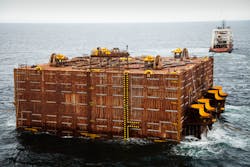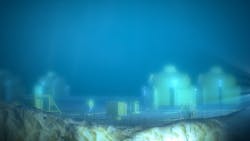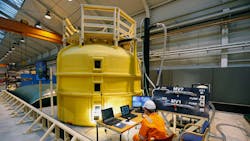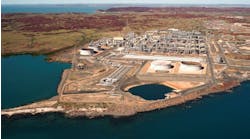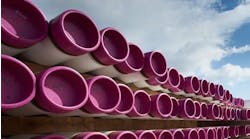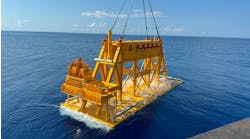Subsea storage may provide a cost-effective field development option for temporarily storing produced oil. This option is attractive in fields where discovered reserves do not justify the construction of new pipelines; and in areas where there is no existing pipeline infrastructure.
Although not new in concept – the idea goes back at least to the 1960s – the design has been employed in the Solan oil field, located in 135 m of water in the UK North Sea, west of Shetland. The system has been operating successfully since the field was placed online in April 2016.
At the Solan field, produced oil is stored in a specially designed steel subsea oil storage tank (SOST) that is located ~300 m from the platform. Oil is transferred from the tank to shuttle tankers, and then to market.
The relatively remote field was developed with four subsea wells tied back to a single slim jacket with a minimum facility topsides. The subsea oil storage tank concept was described by Premier Oil officials in an SPE paper that focused on its operation one year after it had been commissioned (SPE-186161-MS). According to Premier Oil, besides the SOST, the development includes several innovative features such as full automation, which enables full remote control from an onshore control room in Aberdeen.
The concept selection of the SOST was driven by several factors including HSE, life cycle cost, and operational considerations for this modest-sized development that was also located in a harsh marine setting. Premier Oil officials assessed the alternative option of developing the field with a subsea well and an FPSO alternate, but selected the SOST based on environment and cost.
The engineering contractor Atkins provided technical support for the Solan subsea oil storage tank project, from concept development work to FEED and then detailed design work.
The multiple-compartment SOST is capable of holding almost 300,000 bbl of stabilized oil; it has an in-air weight of ~10,100 tonnes and internal dimensions of 45 m x 45 m x 25 m. The oil is offloaded to a shuttle tanker through a single anchor loading system with the offloading hose stored on the seabed, which is picked up using a pennant line. Oil export to the tanker is driven by hydrostatic displacement by treated seawater from the topsides.
This operation is conducted while oil is being produced to the SOST. Premier Oil says that the tank design has novel features for installation, oil-water interface management, and corrosion monitoring and subsea inspection.
The tank’s detailed design and construction phase involved some significant changes as the structural and fatigue life issues were fully analyzed and implemented. The installation required significant pre-planning with the use of a large lifting sling arrangement and a smart air venting and water ballasting system, to then land its eight skirt piles to a tight tolerance on the seabed.
Following a commissioning program and trial tanker offload using treated seawater alone, the SOST has now successfully undergone numerous oil fill and tanker offload operations. Premier Oil says that there have been lessons learned with regard to the offloading operations, but adds that to date the concept has worked in a manner close to expectation with a full tank offload achieved in less than ~36 hours.
Other systems
Oilfield services and equipment provider National Oilwell Varco (NOV) is advancing its own Subsea Storage Unit (SSU) solution, which it says enables storage of crude oil, chemicals and produced water on the subsea floor.
The company says that the SSU is a gravity-based storage unit that employs a flexible bag protected by a dome, a design that it says helps ensure long-term competitiveness and continued profitable development of the petroleum resources. According to NOV, the system offers a safe, cost-effective method of developing subsea fields in extreme weather zones or in the Arctic where ice is prevalent.
The SSU consists of a collapsible bag containing the entire stored volume, which eliminates contact between stored medium and sea water. The bag is protected by a protection structure (dome) which accommodates the entire volume. Hence, there is no need to design against pressure and the unit can be deployed at any water depth.
NOV says that the subsea storage system can be applied during well testing and early production start-up; and that storage capacity can be added as the production rate increases. The storage is flexible in size depending on field needs during development, expansion and end of field.
Perth-based Tensa Equipment has developed a concrete subsea storage tank (CSST) that is designed for oil export to shuttle tankers. The company says that the CSST can give operators the ability to install and readily relocate a storage unit to alternative field locations at minimal cost. Special features include the ability to moor an offtake tanker to the storage tank, the incorporation of a membrane to separate the oil and ballast water, and no requirement for additional ballast even when used in cyclone prone locations. •
